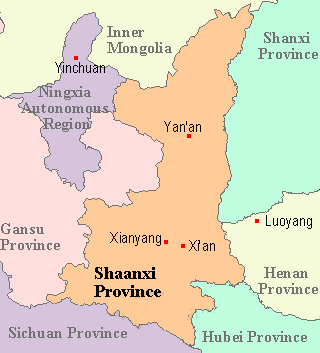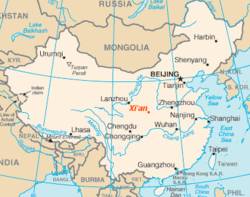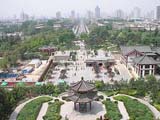Xi'an Life
 Xi'an is the capital of Shaanxi province in China and
a sub-provincial
city. As one of the most important cities in Chinese history, Xi'an is
one of the four great ancient capitals of China for it has been the capital
of 13 dynasties, including the Zhou, Qin, Han,
and the Tang.
Xi'an is also renowned for being the eastern terminus of the Silk
Road and for the location of the Terracotta Army from Qin Dynasty. Called
Chang'an in ancient times, Xi'an city has more than 3,100 years of history. Xi'an is the capital of Shaanxi province in China and
a sub-provincial
city. As one of the most important cities in Chinese history, Xi'an is
one of the four great ancient capitals of China for it has been the capital
of 13 dynasties, including the Zhou, Qin, Han,
and the Tang.
Xi'an is also renowned for being the eastern terminus of the Silk
Road and for the location of the Terracotta Army from Qin Dynasty. Called
Chang'an in ancient times, Xi'an city has more than 3,100 years of history.
Xi'an served as the seat of 12 imperial capitals for 1,120 years. It is well-known
as the "cradle of Chinese civilization" for its history, archaeological
treasures and rich cultural heritage. Now it is the capital of Shaanxi Province,
and also a world-famous tourist city known for its treasure house of cultural
relics, museums, and historical sites.
Since 1990s, as part of the economic revival of interior China, especially
the central and northwest regions, in addition to a history of manufacturing
and solid industrial establishments, Xi'an has become an important cultural,
industrial and educational center of the central-northwest region, with facilities
for research and development, national
security and China's space exploration program.
Even before the lives of Christ, Mohammad, and Siddhartha, Xi'an was a world
class city already influencing the world outside of The Great Wall of China.
As the eastern terminus of the Silk Road during the Han dynasty during 206
BC - 220 AD, traders from far and wide exchanged goods and ideas with China,
and bringing back new treasures and knowledge back to their home communities.
In the present times, not much of its former glory remains within the city
due to warfare and constant political changes throughout the ages.
 Xi'an is located on the longitude and latitude of 33 North and 107 East, in
the southern part of Guanzhong Plain in Shaanxi province with Qinling Mountains
to the north and the Weihe River to the south. Its neighboring areas are Shanxi,
Henan, Hubei, Sichuan, Gansu Provinces, Ningxia Hui and Inner Mongolia Autonomous
Regions. With an elevation of 500 meters, the Weihe Plain extends between Baoji
in the west and Tongguan in the east and borders the Qinling Mountains in the
south and the Huangtu Plateau in the north. Xi'an lies in the centre to the
south of this plain, a favorable geographical location surrounded by water
and hills. Xi'an is located on the longitude and latitude of 33 North and 107 East, in
the southern part of Guanzhong Plain in Shaanxi province with Qinling Mountains
to the north and the Weihe River to the south. Its neighboring areas are Shanxi,
Henan, Hubei, Sichuan, Gansu Provinces, Ningxia Hui and Inner Mongolia Autonomous
Regions. With an elevation of 500 meters, the Weihe Plain extends between Baoji
in the west and Tongguan in the east and borders the Qinling Mountains in the
south and the Huangtu Plateau in the north. Xi'an lies in the centre to the
south of this plain, a favorable geographical location surrounded by water
and hills.
 Living conditions in Xi'an have improved at the fastest rate of all Chinese
cities. However, it is not one of the most lived in cities for foreigners in
China due to the lack of suitable facilities and its harsh climate. Though
this may deter some foreigners who prefer to live in developed cities such
as Beijing and Shanghai, Xi'an remains as an exciting adventure for many foreigners
in China. Living conditions in Xi'an have improved at the fastest rate of all Chinese
cities. However, it is not one of the most lived in cities for foreigners in
China due to the lack of suitable facilities and its harsh climate. Though
this may deter some foreigners who prefer to live in developed cities such
as Beijing and Shanghai, Xi'an remains as an exciting adventure for many foreigners
in China.
Xi'an, like other cities in China, is generally quite safe. Just watch out
for pickpockets (usually children) in crowds. Pickpockets are more readily
found during holidays and pick pocketing is more likely to happen on the bus
and in crowded areas.
Xi'an is the largest industrial center in the mid-west and northwest of China.
Furthermore, the city has consistently received one of the largest amounts
of foreign direct investments amongst cities in western China. The industrial
sector makes up more than 60% of the total trading volume, and as much as 97%
of the industries are based in manufacturing. Nowadays, Xi'an is also known
for its software park and it also has the largest aviation manufacturing center
in Asia.
|